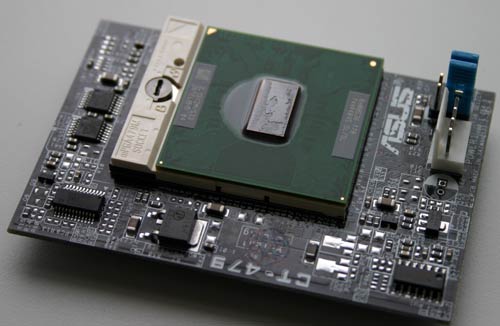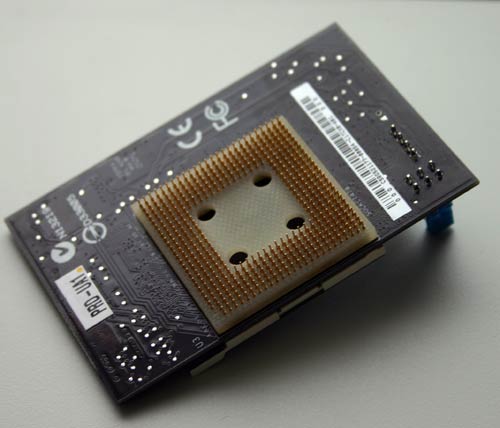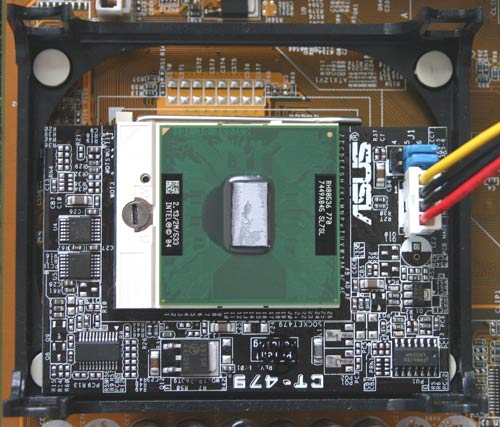Intel's Pentium M Desktop Part II: ASUS' Pentium M to Pentium 4 Socket Adapter
by Anand Lal Shimpi on March 24, 2005 1:31 PM EST- Posted in
- CPUs
ASUS CT-479: Socket-478 to Socket-479 Adapter
Enter the ASUS CT-479 CPU Upgrade Kit, an adapter board that will convert specific ASUS Socket-478 motherboards to support Pentium M CPUs. You will remember from our original Pentium M desktop article that the pinout of the Pentium M is different than the Pentium 4, although the two chips are electrically compatible (they use the same FSB). The next problem is that the Pentium M relies on a much lower voltage version of the Pentium 4's FSB, which is also addressed by ASUS' adapter, a problem that we did not think was solvable until now.
The CT-479 only works with ASUS motherboards, and only a limited number of them at that. Currently, only the ASUS P4P800-SE and P4P800-VM motherboards are supported, both of which are i865 based motherboards. ASUS is working on support for other boards; the P4C800-E (875P) will be supported soon. For our tests, we used a P4P800-SE; you need a BIOS update, but that's all. Obviously, non-ASUS motherboards are not supported; however, we're not certain whether or not the adapter can be made to work in other boards. We will be looking into this as time goes on, but we wanted to make sure that we could complete this article first before doing anything that would damage our setup.


The CT-479 supports all Pentium M and Celeron M CPUs (Dothan and Banias based) with the exception of the Low Voltage and Ultra Low Voltage versions.

The jumpers switch between 400 and 533MHz FSB settings. The power connector powers the adapter.
The CT-479 comes with the adapter board, heat sink/fan and power cable.

A perfect fit

The supplied heat sink is specifically made for the CT-479.
Currently, ASUS is listing the CT-479 as a part of a bundle with the P4P800-SE, priced at $130. At that price, the solution is almost half the price of the AOpen/DFI motherboards, and you get all of the benefits of the 865 chipset. The main benefit of the 865 chipset in this case is its dual channel DDR400 memory controller. The 533MHz FSB Pentium Ms are memory bandwidth starved by the 855GME's single channel DDR333 memory controller, so being paired with an 865 gives the CPU more memory bandwidth than it can use.
The P4P800-SE that we tested only allowed for 5:4 and 1:1 memory clock speed ratios, meaning that for our 533MHz FSB Pentium M, the maximum stock memory clock was DDR333. But since we're talking about a dual channel memory controller, even at DDR266 speeds, you have enough memory bandwidth for the processor - DDR400 support isn't necessary.
The other major benefit of the CT-479 is that you get to use a mature, mass-produced ASUS motherboard instead of a smaller production run, recently released 855GME solution. The benefits were clear in our testing - overclocking the Pentium M was far less of an ordeal on the ASUS solution.
The CT-479 does not support the Pentium M's SpeedStep technology, which has a handful of implications:
1) System power consumption will be higher on the ASUS solution than on 855GME based systems from AOpen/DFI. The reason being that the CPU will always run at maximum frequency, which is still lower power consumption than any other desktop processor, but it is worth mentioning.
2) You can't adjust the clock multiplier of the Pentium M like you can on the AOpen/DFI offerings. This will hamper the more adventurous overclockers, but it's definitely not a show stopper.
You also can't adjust the Pentium M's core voltage when using the CT-479; you're stuck at the default voltage. ASUS' Q-Fan technology (which allows for the automatic reduction of fan speed depending on thermal load) is supported, so you can reduce noise output even if SpeedStep isn't supported.
ASUS just announced the CT-479 last week, so there are some details that aren't yet available, such as whether or not the kit will be offered outside of the ASUS motherboard bundle. As soon as we have this information, we'll pass it along, but even if the only way to get it is with an ASUS motherboard, it is still a much better value than a standalone Pentium M motherboard.
The question here is how big of an impact does the 865 chipset have on the desktop performance of the Pentium M? To find out, we paired it with the Pentium M 770, Intel's fastest Pentium M running at 2.13GHz. The Pentium M 770 requires a 533MHz FSB, which is supported by the 865 chipset, and thus, is also supported by the CT-479 upgrade kit.
The Test
Our hardware configurations are similar to what we've used in previous comparisons.
AMD Athlon 64 Configuration
Socket-939 Athlon 64 CPUs
2 x 512MB OCZ PC3200 EL Dual Channel DIMMs 2-2-2-10
NVIDIA nForce4 Reference Motherboard
ATI Radeon X800 XT PCI Express
Intel Pentium 4 Configuration
LGA-775 Intel Pentium 4 and Extreme Edition CPUs
2 x 512MB Crucial DDR-II 533 Dual Channel DIMMs 3-3-3-12
Intel 925XE Motherboard
ATI Radeon X800 XT PCI Express
Intel Pentium M Configuration
Intel Pentium M 725 - 755
2 x 512MB OCZ PC3200 EL Dual Channel DIMMs 2-2-2-10
AOpen GMEm-LFS Motherboard
ASUS P4P800-SE + CT-479 Adapter
ATI Radeon X800 XT AGP










48 Comments
View All Comments
Houdani - Thursday, March 24, 2005 - link
With updates to floating point calculations and adding another core, Intel will need to think long and hard about putting their desktop chips into premature end-of-life in favor of going forward with the PM as their base product.Or, to summarize:
Blah blah blah nothing new that hasn't already been said before blah blah blather.
mlittl3 - Thursday, March 24, 2005 - link
Anand,You completely missed the point of the excellent data you obtained. Of course, this is just my point of view but here is my take on things.
The Pentium III stopped at 1.4 GHz. The Pentium picked up at 1.5 GHz (not including the low and ultra low voltage versions). We all know that the Pentium M is much more similar to the Pentium III than the Pentium IV. What if Intel never created the Pentium IV and continued improvements with the Pentium III? We would have had the Pentium M three to four years ago.
Intel screwed us all with its monopoly powers and sold high clock speeds to the masses with no thought about the performance of the Pentium IV. The last four years have shown us just that but no one complains or holds Intel accountable. As you have pointed out numerous times, the capital processor of the Pentium IV series, the Pentium IV EE is a complete waste of money.
In almost all of your benchmarks, the Pentium M shows almost the EXACT same performance as an Athlon 64 clock for clock. I say again, what if the Pentium M was developed at the time the Pentium III was discontinued? Intel and AMD would have matched clock speeds and we would have a Pentium M around 2.6 GHz right now with the similar performance of the Athlon 64 FX-55. The improvements you mentioned in the conclusion for Yonah (SSE and floating point) would probably already be implemented.
The Pentium M is THE processor from Intel. We had to wait four years for Intel's monopoly to be weakened but now we have a processor worth something. With multiple cores (each running at the speed of single cores since the Pentium M runs so cool) and all the other improvements from Yonah, that processor is going to be awesome.
Thank god for AMD challenging Intel with their terrific Athlon 64 architecture. Without them, computer processing would be in the dark ages. Guys, we need to stop supporting companies when they get to a certain size. The market needs to shift or we are going to get software like Windows and processors like the Pentium IV. With an even market share split between at least two companies, technology will excel past our wildest imaginations.
Okay, I will shut up now. I do want to add one thing. The ASUS adapter does nothing over the Aopen motherboard. If I am not mistaken, you compared a 533 MHz FSB, 133 MHz faster Dothan Pentium M to 400 MHz FSB, slower Dothans (I hope the other processors were Dothans and not Banias). The performance delta between the 770 and the 750 is exactly what you would expect from a faster clocked processor and a faster FSB. The 865 vs. the 855GME had nothing to do with the performance difference. The only advantage of the ASUS adapter is a cheaper overall cost of ownership.
bob661 - Thursday, March 24, 2005 - link
Oh yeah, if you're going Intel, this is the only CPU to own.bob661 - Thursday, March 24, 2005 - link
Intel really needs to lower the price of this CPU. A 765 is $645 on newegg. I can only imagine what the 770 would cost. If it was more price competitve, the P-M would be an excellent processor choice.rqle - Thursday, March 24, 2005 - link
i thought it did pretty well clock for clock on majority of the benchmark against the amd64 and did on par or so on gaming against the amd FX chips. Where it exceeds the PM it deal extremely well, and falls really shorts on things it didnt fair to well.Price wise for a "Desktop", i still believe AMD64 chip is the way to go. Great notebook chip that is not quite ready for the desktop area yet, need to improve its floating point performance and some desktop area. Did pretty well as gaming chip.
clarkey01 - Thursday, March 24, 2005 - link
Multitasking..lol...I mean, your going to get Intel fanboys saying " Its only has a 400 MHZ FSB" and what not. Well, why has it > ? its like saying the FX only has one meg cache, why doesnt it have two ?
clarkey01 - Thursday, March 24, 2005 - link
Mixed bag or what.Aileur - Thursday, March 24, 2005 - link
All in all seems like a middle of the pack solution. I thought the dual channel would give it a more significant boost but the pentium m seems to stay in the middle of the pack most of the time.I would still get it before i ever touched a prescott with a ten foot pole (and im an ex northwood user) but for the price theyre asking for dothans I dont see it being the desktop chip killer i was expecting.
I wonder though how Intel could clock this thing if it didnt have low power/heat in mind.